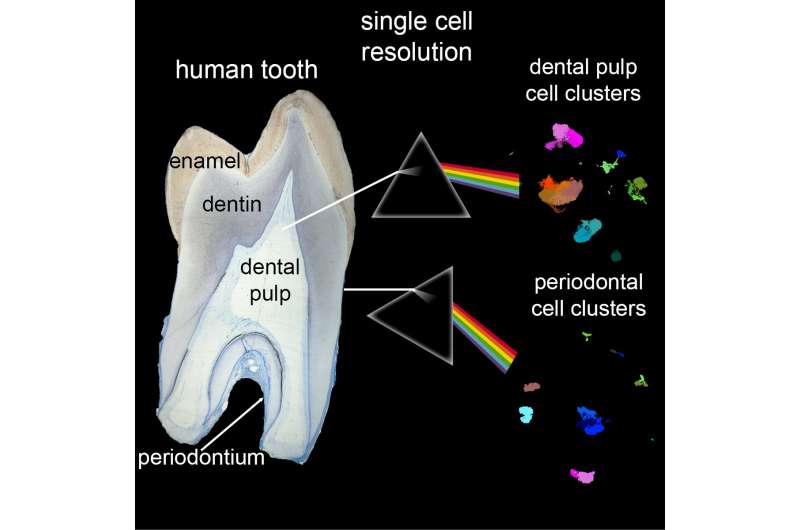The first comprehensive single-cell atlas of human teeth


Researchers at the University Zurich have mapped the first complete atlas of single cells that make up the human teeth. Their research shows that the composition of human dental pulp and periodontium vary greatly. Their findings open up new avenues for cell-based dental therapeutic approaches.
During the last 30 years, medical and dental research has attracted a large number of scientists and practitioners working on aspects of high medical relevance that involve a combination of genetic and tissue regeneration approaches. These developments in stem cell and tissue engineering have provided medical and dental researchers with new insights and given rise to new ideas as to how everyday clinical practice can be improved. Many research groups are dealing with questions like: How can we help injured tissues and organs heal? Can lost tissue be regenerated? How can we create solid protocols that apply across all stem cell therapies?
Advanced single-cell sequencing technology used
A team of researchers led by Thimios Mitsiadis, professor at the Institute of Oral Biology at the University of Zurich, and Dr. Andreas Moor, professor at the Department of Biosystems Science and Engineering at ETH Zurich, has now created the first-ever single cells atlas of the human teeth. By using advanced single-cell sequencing technology, they were able to distinguish every single cell that is part of the dental pulp and the periodontium. “Our study provides an unprecedented understanding of the composition of these two tissues, which are subject to tooth-specific and bacterially-linked pathologies such as caries and periodontitis. Both the dental pulp and the periodontium contain stem cells that possess a great regenerative potential,” states first co-author Pierfrancesco Pagella, senior researcher in Mitsiadis’ team.
The study identified great cellular heterogeneity in the dental pulp and the periodontium. Unexpectedly, the team found that the molecular signatures of the stem cell populations were very similar. “We think their different behavior is possibly brought about by their distinctive microenvironment,” says Pagella. The findings suggest that the microenvironmental specificity is the potential source of the major functional differences of the stem cells located in the various tooth compartments.
New cell-based dental therapies possible
The study demonstrates the complexity of dental tissues and represents a major contribution to a better understanding of the cellular and molecular identity of human dental tissues. “Single-cell approaches can help us understand the interactions of dental pulp and periodontal cells involved in immune responses upon bacterial insults. Therefore, single-cell analysis could be useful for diagnostic purposes to support the early detection of dental diseases,” last author Thimios Mitsiadis explains. The findings thus open up new avenues for cell-based dental therapeutic approaches.
Source: Read Full Article